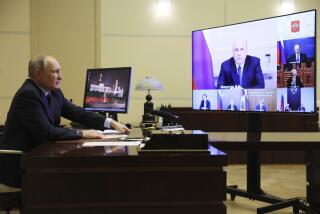NUCLEAR ARMS : U.S.-Soviet Nuclear Treaties Have Downside: High Verification Cost
- Share via
WASHINGTON — The recent, largely unnoticed ratification of two U.S.-Soviet treaties to limit underground nuclear testing is having an unexpected--and unpleasant--effect: It is dramatically increasing the costs of curbing underground nuclear testing.
The reason is simple. For the last 15 years, the two countries have limited the power of underground tests (to the equivalent of 150,000 tons of TNT) without any formal policing mechanisms. Ratification of the treaties last month merely codified existing limits.
But the treaties call for establishing elaborate and expensive verification procedures that are likely to force both superpowers to spend millions of dollars extra on test limitation, despite the recent lessening of U.S.-Soviet tensions.
Indeed, the U.S. On-Site Inspection Agency estimates that carrying out the verification provisions in the two treaties during the next three years will cost the United States $100 million more than what was needed to monitor nuclear tests from a distance.
“If we don’t push all our rights to the limit, some people might say we’re showing the Soviets we’re not serious about verification,” a Pentagon official asserts. “We lived without these rights. Now, we have to live with them.”
The anomaly illustrates one of the major ironies in arms control these days. Although the Cold War is essentially over, the United States is saddled with the verification standards that it demanded in the Cold War days, when politicians insisted that no cheating go undetected.
Although such absolute assurance is virtually impossible, U.S. officials believed they still had to include enough verification provisions in the treaties to satisfy political demands--even though they add to the costs and aren’t vital to national security.
“The political realities are such that agreements to be submitted for legislative approval must adhere to higher standards in terms of verifiability and equality than the United States would require for its security in the absence of formal agreements,” the State Department’s Robert Einhorn wrote in the journal of the International Institute for Strategic Studies in London.
By contrast, U.S. national security officials are more pragmatic. The Pentagon, for example, worries only about cheating that is “militarily significant.” It wants big violations to be detected early enough to enable America to devise similar weapons or effective counter-weapons.
Part of the reason for today’s seeming overkill on the verification issue is historical. Thirty years ago, when neither side trusted the other as much as an inch, the superpowers prohibited tests in the air, space and sea, where almost any violation could be easily detected.
But treaties to limit underground explosions, which are more difficult to identify and measure, weren’t signed until 1974 and 1976. And even then, successive administrations insisted on extensive on-site verification procedures before submitting the pacts for ratification.
U.S. officials did not expect to get all of their demands satisfied, but in the new Soviet era of glasnost (openness), they did--and more. Disagreements over which of two techniques to employ, for example, were resolved by agreeing to use them both.
As a result, redundancies in the program abound. For example, the new treaties provide for three new monitoring procedures for each side. These are on-site visits and sample-gathering, electronic cable measurements underground at the site of the test and seismic signals recorded at three locations within each country.
The new treaties also have brought new pressures on the United States to halt all underground nuclear testing. But the Administration, like its predecessor, insists that continued testing is needed to develop safer weapons that are more immune to accidents.
More to Read
Sign up for Essential California
The most important California stories and recommendations in your inbox every morning.
You may occasionally receive promotional content from the Los Angeles Times.













